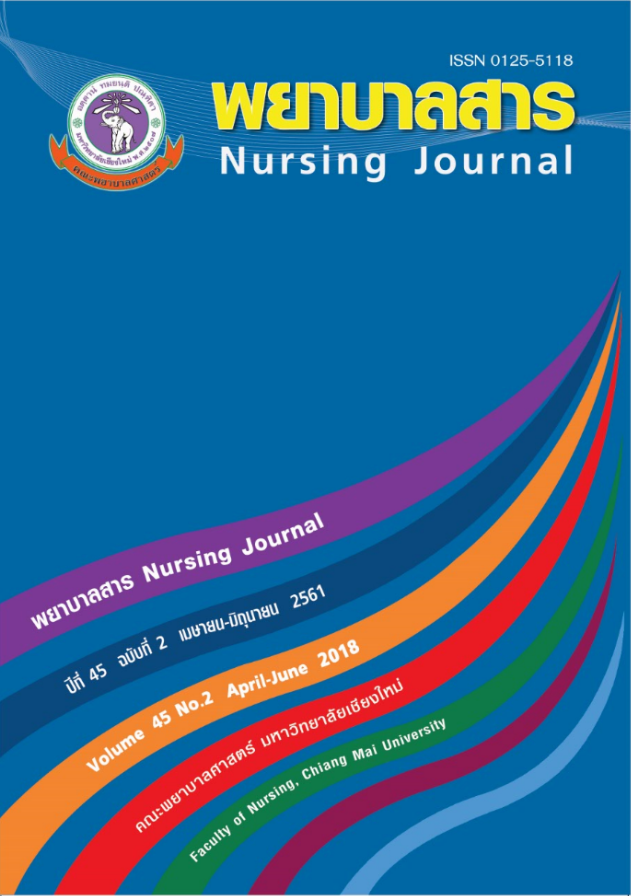ความรู้และพฤติกรรมเกี่ยวกับอาหารปลอดภัยในสตรีตั้งครรภ์
คำสำคัญ:
อาหารปลอดภัย, ความรู้, พฤติกรรม, สตรีตั้งครรภ์บทคัดย่อ
สตรีตั้งครรภ์และทารกในครรภ์มีความเสี่ยงในการได้รับผลกระทบจากอาหารไม่ปลอดภัย แต่ยังไม่มีหลักฐานเชิงประจักษ์เกี่ยวกับความรู้และพฤติกรรมอาหารปลอดภัยในสตรีตั้งครรภ์ไทย การวิจัยนี้มีวัตถุประสงค์เพื่อหาความสัมพันธ์ระหว่างความรู้และพฤติกรรมเกี่ยวกับอาหารปลอดภัยในสตรีตั้งครรภ์ ซึ่งแบ่งออกเป็น 5 ด้าน คือ 1) การรักษาความสะอาด 2) การแยกอาหารดิบและสุก 3) การปรุงสุก 4) การรักษาอาหารในอุณหภูมิที่พอเหมาะ และ 5) การใช้น้ำและวัตถุดิบที่ปลอดภัย เครื่องมือทีใช้ในการวิจัย ได้แก่ (1) แบบสอบถามข้อมูลส่วนบุคคลของสตรีตั้งครรภ์ (2) แบบวัดความรู้เกี่ยวกับอาหารปลอดภัยในสตรีตั้งครรภ์ และ (3) แบบวัดพฤติกรรมเกี่ยวกับอาหารปลอดภัยในสตรีตั้งครรภ์ กลุ่มตัวอย่างเป็นสตรีตั้งครรภ์ จำนวน 200 ราย ที่มารับบริการฝากครรภ์ ณ โรงพยาบาลมหาราชนครเชียงใหม่ และโรงพยาบาลส่งเสริมสุขภาพ ศูนย์อนามัยเขต 1 เชียงใหม่ ระหว่างเดือนพฤษภาคม ถึงมิถุนายน พ.ศ. 2559 คัดเลือกกลุ่มตัวอย่างแบบตามสะดวก ร้อยละ 39.50 ของกลุ่มตัวอย่าง มีอาการผิดปกติในระบบทางเดินอาหารในระยะตั้งครรภ์ โดยส่วนใหญ่เป็นอาการท้องอืด และท้องเดิน/ท้องเสีย
ผลการวิจัย พบว่า คะแนนเฉลี่ยความรู้เกี่ยวกับอาหารปลอดภัย จัดอยู่ในระดับสูง เท่ากับ 32.19 คะแนน (S.D.= 6.73) จากการแบ่งเป็น 5 ระดับ คือ ต่ำมาก ต่ำ ปานกลาง สูง และสูงมาก ด้านที่จัดอยู่ในระดับต่ำ คือ การรักษาอาหารในอุณหภูมิที่พอเหมาะ ( = 1.84 S.D.=1.37) ส่วนคะแนนเฉลี่ยพฤติกรรมเกี่ยวกับอาหารปลอดภัยในสตรีตั้งครรภ์ของกลุ่มตัวอย่าง จัดอยู่ในระดับสูง เท่ากับ 79.52 คะแนน (S.D. = 9.65) จาการแบ่งเป็น 5 ระดับ เหมือนกับความรู้เกี่ยวกับอาหารปลอดภัย ด้านที่จัดอยู่ในระดับปานกลาง คือ การรักษาอาหารในอุณหภูมิที่พอเหมาะ ( =8.63 S.D.=1.95) จากสถิติสัมประสิทธิ์สหสัมพันธ์สเปียร์แมน ความรู้เกี่ยวกับอาหารปลอดภัยในสตรีตั้งครรภ์มีความสัมพันธ์ทางบวกกับพฤติกรรมเกี่ยวกับอาหารปลอดภัยในสตรีตั้งครรภ์อย่างมีนัยสำคัญทางสถิติ (r=.37, p<.001)
ข้อเสนอแนะ คือ ควรมีการให้สุขศึกษาแก่สตรีตั้งครรภ์ โดยเฉพาะอย่างยิ่งด้านการรักษาอาหารในอุณหภูมิที่พอเหมาะ นอกจากนั้นควรมีการสำรวจในทำนองเดียวกันในสตรีตั้งครรภ์ที่อาศัยอยู่ในพื้นที่ชนบท รวมทั้งปัจจัยที่เกี่ยวข้องกับความรู้และพฤติกรรมอาหารปลอดภัยในสตรีตั้งครรภ์
เอกสารอ้างอิง
คมสัน วัฒนเทพ. (2549). ปัจจัยที่เกี่ยวข้องกับพฤติกรรมการบริโภคอาหารปลอดภัยของประชาชนอำเภอ บางแพ จังหวัดราชบุรี. (วิทยานิพนธ์วิทยาศาสตรมหาบัณฑิต). บัณฑิตวิทยาลัย,
มหาวิทยาลัยศรีนครินทรวิโรฒ.
จริยา สอนภักดี. (2544). ปัจจัยทางจิตวิทยาที่มีผลต่อพฤติกรรมการบริโภคอาหารของแกนนำ สาธารณสุข ประจำครอบครัว อำเภอแกลง จังหวัดระยอง. (วิทยานิพนธ์ศิลปะศาสตรมหาบัณฑิต สาขาวิชา คหกรรมเพื่อพัฒนาชุมชน). บัณฑิตวิทยาลัย, มหาวิทยาลัยรามคำแหง.
จินตนา ยูนิพันธ์. (2540). การพยาบาลห้องผ่าตัด: บทบาทเชิงรุก. ใน การประชุมวิชาการชมรมพยาบาล ห้องผ่าตัดแห่งประเทศไทย. กรุงเทพฯ: ไพศาลศิลป์การพิมพ์.
ชวันลักษณ์ ไทยทรงธรรม. (2548). ความรู้และการปฏิบัติตัวตามหลักสุขาภิบาลอาหารของผู้สัมผัสอาหาร ใน แผงลอยจำหน่ายอาหาร. (การค้นคว้าแบบอิสระวิทยาศาสตรมหาบัณฑิต สาขาวิชาโภชนศาสตร์ศึกษา). บัณฑิตวิทยาลัย, มหาวิทยาลัยเชียงใหม่.
ประภาเพ็ญ สุวรรณ. (2534). พฤติกรรมศาสตร์พฤติกรรมสุขภาพและสุขศึกษา. กรุงเทพฯ: เจ้าพระยาระบบการพิมพ์.
วสุนธรี เสรีสุชาติ. (2543). การศึกษาพฤติกรรมการบริโภคอาหารของหญิงวัยเจริญพันธุ์ในโรงงาน อุตสาหกรรมที่สัมพันธ์กับภาวะโลหิตจางจากการขาดธาตุเหล็กจังหวัดฉะเชิงเทรา. (วิทยานิพนธ์ มหาบัณฑิต สาขาสังคมศาสตรการแพทย์สาธารณสุข). บัณฑิตวิทยาลัย, มหาวิทยาลัยเชียงใหม่.
ฬุริยา สิริภัทรไพศาล. (2550). พฤติกรรมผู้บริโภคและส่วนประสมทางการตลาดที่มีผลต่อแนวโน้มการ ตัดสินใจซื้อผักปลอดสารพิษในซูเปอร์มาเกต เขตกรุงเทพมหานคร. (วิทยานิพนธ์บริหารธุรกิจ มหาบัณฑิต). บัณฑิตวิทยาลัย, มหาวิทยาลัยศรีนครินทร์วิโรฒ.
อารีย์ พันธ์มณี. (2546). จิตวิทยาสร้างสรรค์ในการเรียนการสอน. กรุงเทพฯ: ใยไหม.
เอก อุ่นจิตต์วรรธนะ. (2548). ปัจจัยทางการตลาดที่มีความสำคัญต่อการตัดสินใจซื้อผักปลอดสารพิษของผู้บริโภคในเขตอำเภอเมือง จังหวัดบุรีรัมย์. (การศึกษาปัญหาพิเศษบริหารธุรกิจมหาบัณฑิต). บัณฑิตวิทยาลัย, มหาวิทยาลัยมหาสารคาม.
Atherarn, P. N., Kendall, P. A., Val-Hillers, V., Schroeder, M., Bergmann, V., Chen, G., … & Medeiros, L. C. (2004). Awareness and acceptance of current food safety recommendations during pregnancy. Maternal and Child Health Journal, 8(3), 149-162.
Barrett, E. S., Sathynarayana, S., Janssen, S., Redmon, J. B., Nguyen, R. H. N., Kobrosly, R., … & Swan, S. H. (2014). Environmental health attitudes and behaviors: finding from a large pregnancy cohort study. European Journal of Obstetrics and Gynecology and Reproductive Biology, 176, 119-125. doi: 10.1016/j.ejogrb.2014.02.029
Bermudez-Millan, A., Perez-Escamilla, R., Damio, G., Gonzalez, A., & Segura-Perez, S. (2004). Food safety knowledge, attitudes, and behaviours among Puerto Rican caretakers living in Hartford, Connecticut. Journal of Food Protection, 67(3), 512-516.
Borzsonyi, M., Bereczky, A., Rudnai, P., Csanady, M., & Horvath, A. (1992). Epidemiological studies on human subjects exposed to arsenic in drinking water in southeast Hungary. Archives of Toxicology, 66(1), 77-78.
Concha, G., Vogler, G., Lezeano, D., Nermell, B., & Vahter, M. (1998). Exposure to inorganic arsenic metabolites during early human development. Oxford Journals Toxicological Science, 44, 185-190. doi: 10.1093/toxsci/44.2.185
Cuningham, F. G., Leveno, K. J., Bloom, S. L., Spong, C. Y., Dashe, J. S., Hoffman, B. L., … & Sheffield, J. S. (2014). Williams obstetrics (24th ed.). New York: McGraw-Hill C.
Feng, Y., Bruhn, C., & Marx, D. (2016). Evaluation of different food safety education interventions. British Food Journal, 118(4), 762-776. doi.org/10.1108/BFJ-10-2015-0372
Fukuda, K. (2015). Food safety in a globalized world. Bulletin of the World Health Organization, 93, 212. doi: 10.2471/BLT.15.154831
Golub, M. S., Macintosh, M. S., & Baumrind, N. (1998). Developmental and reproductive toxicity of inorganic arsenic: animal studies and human concerns. Journal of Toxicology and Environmental Health, part B: Critical Reviews, 1(3),199-237.
doi: 10.1080/10937409809524552
Jevsnik, M., Hoyer, S., & Raspos, P. (2008). Food safety knowledge and practices among pregnant and non-pregnant women in Slovenia. Journal of Food Control, 19, 526-534.
Mary, T. J., L-Frederick, N., Zisca, D., & G-Fatma, H. (2007). Food safety practices among pregnant women and mothers in the women, infants, and children program, Miami, Florida. Journal of Food Protection, 70(5), 1072-1294.
Nurhan, U. (2007). Consumer food safety knowledge and practices in the home in Turkey. Journal of Food Control, 18(1), 45-51. doi:10.1016/j.foodcont.2005.08.006
Orem, D. E. (1991). Nursing: concepts of practice (4th ed.). St. Louis, MO: C. V. Mosby.
Papalia, D. E., & Olds, S. W. (1995). Humandevelopment. New York: McGraw-Hill.
Patil, S. R, Cates, S., & Morales, R. (2005). Consumer food safety knowledge, practices, and demographic differences: finding from a meta-analysis. Journal of Food Protection, 68(9), 1884-1894.
Pender, N. J., Murdaugh, C. L., & Parsons, M. A. (2011). Health promotion in nursing practice (6th ed.). New Jersey: Prentice-Hall.
Polit, D. F. (2010). Statistics and data analysis for nursing research (2nd ed.). Saratoga Springs, NY: Humanalysis, Inc.
Puder, K., Rode, A., Kruger, M., & Gonik, B. (2005). Deficits in food safety knowledge during pregnancy. American Journal of Obstetrics and Gynecology, 193(6), S118. doi: http://dx.doi.org/10.1016/j.ajog.2005.10.418
Roberts, S. J. (1988). Social support and help seeking: Review of the literature. Advances in Nursing science, 10(2), 1-11.
Taylor, M., Kelly, M., Noel, M., Brisdon, S., Berkowitz, J., Gustafson, L., … & Galanis, E. (2012). Pregnant women’s knowledge, practices, and needs related to food safety and listeriosis a study in British Columbia. Journal of Canadian Family Physician, 58, 1106-1112.
The U.S. Department of Agriculture Food and Drug Administration (USDA-FDA). (2011).
Food safety for pregnant women. Retrieved From http://www.fda.gov/downloads/ Food/Food borne Illness Contaminants/UCM312787.pdf
Vorvick, L. J. (2014). Food safety. U.S. Department of Health and Human Services. Food safety. Accessed May 3, 2014. Retrieved From https://ummedu/health/medical/ency/articles/food-safety
World Health Organization (WHO) - Regional office for South-East Asia (SEAR). (2015). Food safety: Overview. Retrieved From http://www.searo.who.int/entity/foodsafety/topics/overview/en.
World Health Organization (WHO). (2001). Environmental health criteria 224 (2nd ed.). Geneva: WHO.
World Health Organization (WHO). (2006). Five keys to safer food manual. Retrieved From http://apps.who.int/iris/bitstream/10665/43546/1/9789241594639_eng.pdf
World Health Organization (WHO). (2012). Health education: Theoretical concepts, effective strategies and core competencies. Retrieved From http://apps.who.int/iris/handle/10665/119953
World Health Organization (WHO). (2015). 10 Facts on food safety. Retrieved From http://www.who.int/ features/factfiles/food_safaty/en.
ดาวน์โหลด
เผยแพร่แล้ว
รูปแบบการอ้างอิง
ฉบับ
ประเภทบทความ
สัญญาอนุญาต
บทความที่ได้รับการตีพิมพ์เป็นลิขสิทธิ์ของวารสารพยาบาลสาร
ข้อความที่ปรากฏในบทความแต่ละเรื่องในวารสารวิชาการเล่มนี้เป็นความคิดเห็นส่วนตัวของผู้เขียนแต่ละท่านไม่เกี่ยวข้องกับมหาวิทยาลัยเชียงใหม่ และคณาจารย์ท่านอื่นๆในมหาวิทยาลัยฯ แต่อย่างใด ความรับผิดชอบองค์ประกอบทั้งหมดของบทความแต่ละเรื่องเป็นของผู้เขียนแต่ละท่าน หากมีความผิดพลาดใด ๆ ผู้เขียนแต่ละท่านจะรับผิดชอบบทความของตนเองแต่ผู้เดียว






